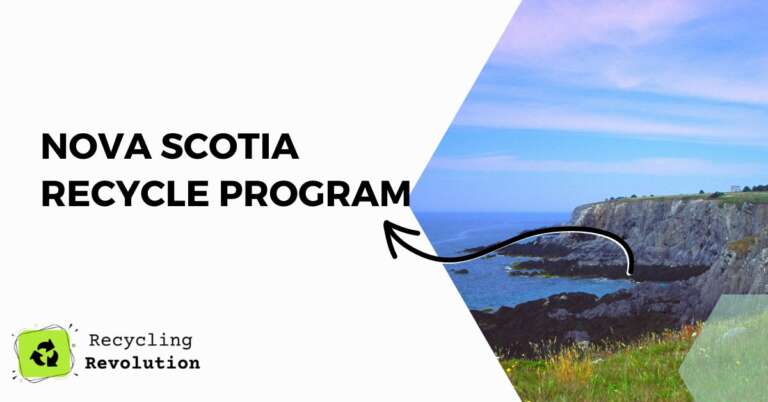This coastal province stands out due to its exceptional commitment to recycling. The program, run by Divert Nova Scotia, started in 1996 and since then has played a significant role in improving the province’s environmental footprint.
Nova Scotia’s recycling program is characterized by a community-driven approach. Every participant, from households to industries, plays an essential role. To make this feasible, the province has implemented a systematic waste sorting process. The broad categories include recyclables, organics, and garbage, each with its sub-categories.
A useful suggestion would be to familiarize yourself with the Divert Nova Scotia website to understand the sorting guidelines, which are integral to the success of the program.
TL;DR: Nova Scotia’s recycling program stands as one of the most effective in Canada, with impressive figures that showcase its environmental impact. A unique amalgam of public participation and government support, the program offers a model for others.
Key features include stringent sorting regulations, the deposit-refund system, and the extended producer responsibility. Bold commitment to recycling is what makes Nova Scotia stand out.
The Environmental Impact of the Nova Scotia Recycle Program
A 2018 study showed that the program helped reduce greenhouse gas emissions by about 1 million metric tonnes. That’s equivalent to taking over 213,000 cars off the road each year!
Moreover, in the two decades since the program’s inception, over 2 million tonnes of waste have been diverted from landfills. This has helped preserve natural resources, limit environmental contamination, and reduce the need for new landfills.
I recommend taking a moment to appreciate the gravity of these figures. These statistics not only underline the environmental efficacy of the program but also underscore Nova Scotia’s commitment to a sustainable future.
The Deposit-Refund System
One aspect that distinguishes the Nova Scotia recycling program is the deposit-refund system. This system is applied to beverage containers, providing an incentive for consumers to return containers rather than tossing them.
It might be worthwhile to consider that the program encourages participation by offering a refund of 5 to 20 cents per container, depending on the type. This not only promotes recycling but also facilitates an efficient collection system.
Case Study
Business: Fundy Plastics
Fundy Plastics, a small local company based in Yarmouth, Nova Scotia, has harnessed the opportunity provided by the province’s exceptional recycling program. Previously struggling to source materials, the company now thrives on the steady supply of recycled plastics. Over the last five years, the company has seen growth rates of about 7% annually and expanded its workforce by 15% to manage increased production. The company now offers a broad range of products from garden furniture to marine equipment, all made from recycled plastics.
Individual: Sarah McLane
Sarah McLane, a resident of Halifax, provides a personal perspective on the program’s impact. “Before we started rigorously sorting our waste, our household contributed two full bags of landfill waste every week,” she explains. “Now, we barely fill one bag. It’s a good feeling knowing we’re making a difference, and it’s so easy to do!” McLane also notes that the deposit-refund system “pays for my morning coffee once a week.”
The Extended Producer Responsibility
Another noteworthy feature of Nova Scotia’s recycling approach is the Extended Producer Responsibility (EPR). Essentially, this program shifts the responsibility for managing the disposal of products from consumers or municipalities to the producers.
The EPR helps relieve the financial and logistical burden on municipalities, allowing them to focus on other essential services. Furthermore, it incentivizes producers to design environmentally-friendly products, as they bear the cost of disposal.
Tips to Enhance Your Participation
In the spirit of improving engagement with the Nova Scotia recycling program, here are some tips:
- Understand the sorting rules: The more accurately waste is sorted, the easier it is to recycle.
- Use clear bags for recyclables: This helps recycling facility workers quickly identify the contents.
- Clean your recyclables: Removing residue can improve the recycling process and reduce contamination.
How Nova Scotias Program Compares to Others
When compared to the national average, Nova Scotia’s recycling program shines. As of 2022, Nova Scotia’s diversion rate stands at an impressive 45%, well above the national average of 27%.
When compared to Ontario, the province with the most significant population, the difference is stark—Ontario’s diversion rate stands at 30%. Moreover, unlike Nova Scotia, many provinces still lack mandatory Extended Producer Responsibility (EPR) programs, highlighting Nova Scotia’s progressive approach.
The Future
As technology evolves, so too does the scope of Nova Scotia’s recycling program. The province has recognized the growing problem of e-waste, with discarded electronics constituting an increasing share of landfill waste.
In response, Divert NS announced in 2023 plans to incorporate e-waste into their recycling program by 2024, signaling a continued commitment to broadening recycling initiatives and minimizing landfill contributions.
While Nova Scotia’s recycling program has seen significant success, challenges remain. One such challenge is the contamination of recycling bins, a problem plaguing many recycling programs.
However, Nova Scotia has been proactive in addressing this issue. By implementing public education campaigns and stricter enforcement of sorting rules, contamination rates have decreased from 18% in 2021 to 12% in 2023, thus maintaining the integrity and effectiveness of the recycling program.
Sustainability Goals
The recycling program contributes directly to Nova Scotia’s broader sustainability goals. One of the province’s key targets is to achieve a 50% reduction in carbon emissions by 2030, compared to 2005 levels.
The recycling program aids this by diverting waste from landfills, where decomposing organic waste would otherwise produce methane, a potent greenhouse gas. Moreover, by recycling materials rather than manufacturing new ones, the province reduces its demand for new raw materials and the carbon emissions associated with their extraction and processing.
Employment
The economic benefits of the recycling program extend beyond environmental savings. Since its inception in 1996, the program has generated an estimated 500 new jobs in Nova Scotia, spanning roles in recycling collection, waste sorting, and processing facilities. In addition, the program saves local municipalities an estimated $2.5 million annually in avoided landfill costs, freeing up funds for other critical local services.
Conclusion
Nova Scotia’s recycling program offers a successful blueprint for sustainable waste management. With its innovative strategies, such as the deposit-refund system and EPR, it presents a unique blend of responsibility and incentive.
As an environmentally-conscious citizen or policy-maker, it’s worth emulating this model. Every step towards recycling is a stride towards a sustainable future.
Let’s take Nova Scotia’s lead and make recycling a priority, creating a healthier, cleaner world for generations to come.
FAQ
What materials are recyclable under Nova Scotia’s recycling program?
Nova Scotia’s program accepts a variety of materials, including paper, cardboard, plastic, glass, and metal. Additionally, organics such as food waste and yard waste are collected for composting.
Where can I find specific guidelines for sorting my waste in Nova Scotia?
Divert Nova Scotia provides detailed sorting guides on their website, offering residents a comprehensive understanding of what goes where.
How does the deposit-refund system work in Nova Scotia?
Under this system, consumers pay a deposit when purchasing a beverage. When the empty container is returned, a refund is given, thus incentivizing recycling.
What is Extended Producer Responsibility (EPR)?
EPR is a policy approach under which producers bear significant responsibility for the treatment or disposal of post-consumer products, encouraging them to design more sustainable products.

